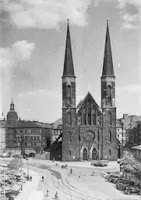St. Sophie’s was a church in Dresden. Valuables found there during its destruction became known as St. Sophie’s treasure. The treasure was on show in the Museum at Dresden until one day it disappeared in broad daylight.
Around 1250, Franciscan monks moved into Dresden and built a monastery with church. In 1351, Margrave Frederic III of Meissen and Thuringia and his wife Countess Katherine of Henneberg donated a new church to the monastery. The old church was only partially torn down and bits and pieces used in the new one. The church was known until the Reformation as the Franciscan Church.
After the Reformation, the monastery was disbanded and the church was used as an arsenal and as a warehouse. 1596, the city ran out of burial space in its other churches and petitioned Prince Elector Christian of Brandenburg to give the meanwhile rather derelict church into the hands of the city council.
The council had no money for the extensive restoration needed, and in 1602 the dowager Princess Sophie of Brandenburg bought the church from the city. The city decided to rename the church St. Sophie’s in her honour at that point. The Princess had the church restored over the next eight years and then handed it back to the city together with a purse of 3,000 Guilder. The church was used after that date for the burials of the nobility and the rich citizens of Dresden until it became the official court church first to the princely and later to the royal court at Dresden.
During the bombardment of Dresden in 1945, the church was completely destroyed by fire. The following winter, the artwork still in situ was collected and stored just before the walls collapsed due to lack of support. 1962, the government of East Germany decided that the space was needed and that the ruins would be destroyed.
The population of Dresden protested against the plans provoking the typical politicians’ reaction. In their haste to grind the will of the people of Dresden in the dust, the high and mighty leaders forgot their most basic history lessons and were taken aback when the destruction crews uncovered precious find upon precious find in the burials in the church.
These objects were called St. Sophie’s treasure and received a place of honor in the municipal museum. They were locked into showcases and a camera system was installed. In 1977, the treasure disappeared from the museum in broad daylight. East German Criminal Police took up the case immediately and started a much publicized investigation. Publication of such a crime was unheard of prior to this theft, and the controls at the borders to West Germany were tightened even more than usual.
But despite these efforts and the inclusion of East Germany’s highly efficient and feared secret police, the case was never solved. After the fall of the Berlin Wall, the East German Criminal Police became part of Germany’s Criminal Police. When finally a piece from the treasure turned up in an auction in England, they pounced to trace its origins. But the auction was the liquidation of the estate of an Anglican bishop, and the only person knowing where the piece came from they could trace was dead.
In 1999, the former director of the municipal museum turned up at the police station with a letter he had received just recently from an art dealer telling him that he had seen pieces of St. Sophie’s treasure in Oslo, Norway. Suddenly, the hunt was on again, and the team of 1977 started working again.
The painstaking reconstruction of the crime took some time, as most information given over to East German Secret Police had disappeared without trace. But the reinvigorated investigation found new and surprising information as well.
It turned out that key personnel of the museum had been called to attend various state courses or just been put on holiday by superior officials removing them on the day of the heist. The investigation by the criminal police was systematically dried up by secret police by requesting material and proofs o be handed over without ever returning them.
The search in Oslo brought forth most of the treasure at a well known antique dealer’s shop who had bought it from a ‘highly respectable’ Danish dealer. As that dealer had died years back, reconstruction of his books brought forth the information that he was heavily involved in dealing with East German art and antiques provided to him by the government directly. As East Germany was in a constant state of bankruptcy, all means to procure money were exploited including stealing from their own museums as well as just confiscating privately owned art and antiques.
The articles were then brought into a warehouse near Berlin where ‘respectable’ art dealers were allowed to view and purchase them. These dealers then either sold the goods directly to customers or brought those to ‘respectable’ auctions such as Christie’s or Sotheby’s giving them the necessary panache of being lawfully obtained.
The investigation is ongoing, but already it paints a rather compelling picture of government crooks and the organized crime called state. It’s a marvelous parable for the uprightness of all politicians and the respectability of the arts and antiques market.
The treasure, as far as it has been recovered to this day, can be seen at the City Museum of Dresden.
Further reading
Cologne Cathedral: Shrine of The Magi
Queen Edith of The Eastern Franks
The Life of Irmingard Princess of Bavaria

No comments:
Post a Comment